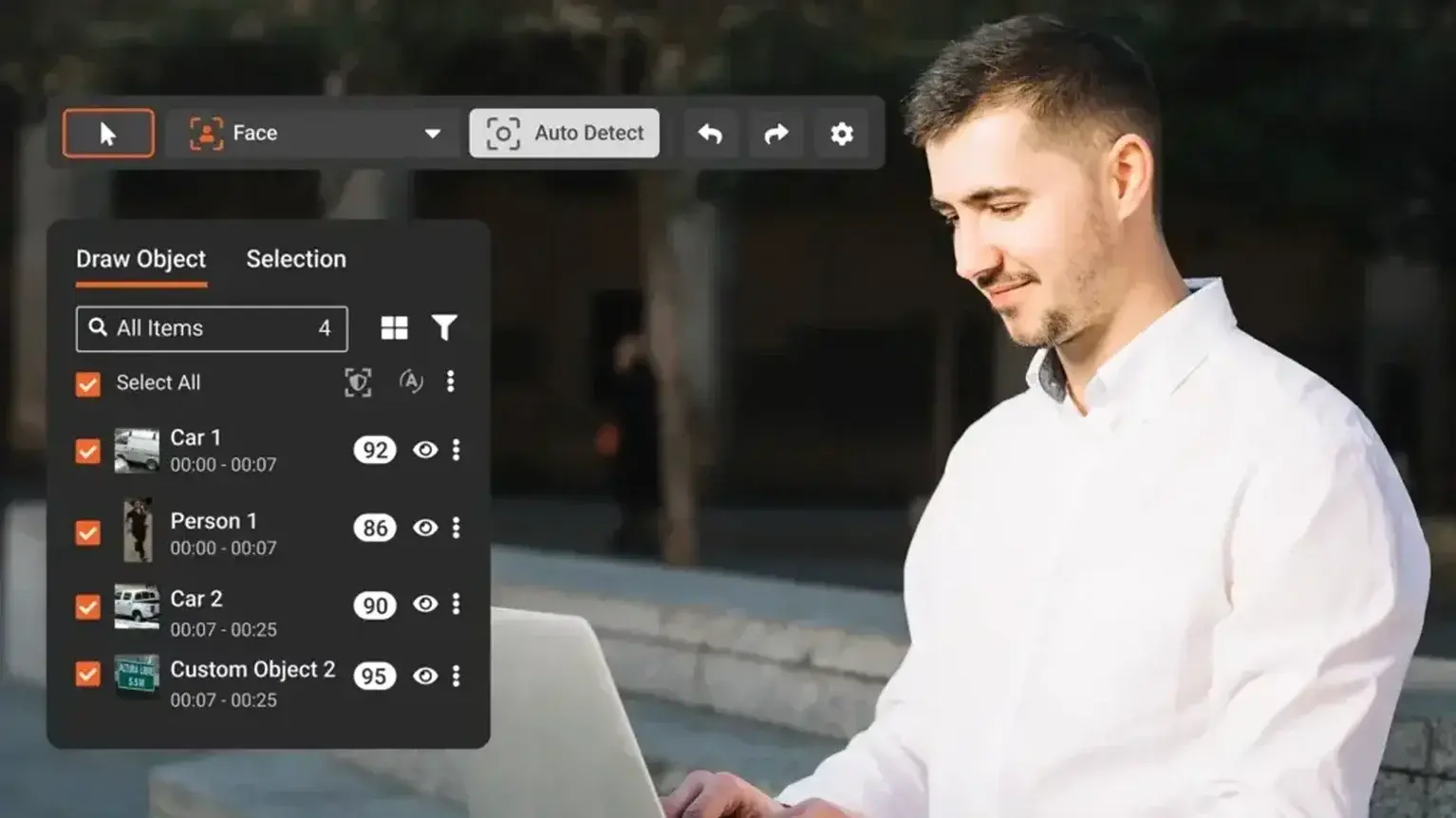Success Stories: Successful Implementations of AI Redaction
by Nohad Ahsan, Last updated: July 25, 2025

In today's data-driven world, protecting sensitive information is a top priority. Regulations like GDPR, HIPAA, and CCPA hold organizations accountable for data privacy. Redaction plays a key role in compliance, but manual methods are impractical for handling large volumes of unstructured data.
The answer lies in AI-powered redaction technology, a scalable solution that uses advanced technologies like machine learning and natural language processing (NLP) to quickly and accurately redact sensitive information across text, audio, and video data.
Gartner has predicted that by the end of 2024, 75% of the global population will have their data protected under modern privacy regulations — a benchmark that remains widely cited in 2025.
This article explores real-world success stories from sectors like healthcare, law enforcement, and finance, showing how redaction helps organizations comply with regulations and boosts operational efficiency and trust.
Understanding the Problem – The High Cost and Risks of Manual Redaction
As data privacy concerns grow globally, the methods used to manage sensitive information must evolve. With mounting regulatory pressures and the increasing volume of unstructured data, manual redaction is no longer a viable solution for most organizations.
The Rising Pressure of Data Privacy Compliance
Data privacy compliance is a pressing concern across industries, with standards set by laws such as the GDPR, HIPAA, and CCPA. Organizations must proactively manage personal information securely, regardless of industry.
With enforcement gaining traction—such as state-led lawsuits against platforms like Temu—non-compliance now carries not just financial penalties but reputational and operational risk
By early 2025, 20 U.S. states had implemented comprehensive consumer privacy laws — and the regulatory patchwork continues to evolve, with recent additions like Maryland, Minnesota and Vermont introducing more stringent obligations.
At the federal level, the proposed American Privacy Rights Act (APRA) could unify standards nationwide — but as of mid‑2025, the bill remains stalled following controversial revisions in committee.
Non-compliance with these regulations risks heavy fines, customer trust, and reputational damage.
Limitations of Manual Redaction
Manual redaction is a labor-intensive process where employees sift through text, video, or audio to obscure sensitive information. However, as data volumes increase, this method becomes time-consuming and error-prone, raising compliance risks. Statista reports that the global average cost per data breach was 4.88 million U.S. dollars in 2024
This emphasizes the financial dangers associated with inadequate data protection. AI redaction, by contrast, enables organizations to quickly and accurately redact sensitive content across diverse formats, mitigating human error and reducing the potential for costly breaches.
The Need for Scalable, AI-powered Solutions
As organizations generate more data, often in complex, unstructured formats like video and audio, the challenges of redaction intensify. AI-powered redaction technology provides a scalable approach to handling data privacy efficiently and accurately.
By employing machine learning, redaction systems can quickly and precisely analyze and redact large volumes of data, reducing the risks and inefficiencies inherent in manual methods.
Expanding on the need for scalable solutions, AI-driven redaction software offers end-to-end automation, which is particularly beneficial for large enterprises. By integrating AI redaction capabilities directly into their workflows, organizations can manage data privacy at scale while enhancing operational efficiency and reducing manual workloads.
The Complexity of Compliance in a Data-Heavy World
As organizations collect and process more data than ever, ensuring compliance with privacy laws becomes increasingly tricky. With unstructured data volumes rising, businesses face an escalating challenge in managing and safeguarding sensitive information.
Managing Unstructured Data with AI Redaction
Businesses today handle diverse unstructured data, from emails and call recordings to surveillance videos and contracts. Unlike structured data, unstructured data does not follow a predefined format, making it particularly challenging to redact manually.
For instance, law enforcement agencies manage vast bodycam footage, which must be redacted before public release to protect individual privacy. Ai-powered redaction tools efficiently detect and conceal sensitive details like faces and license plates while preserving the integrity of the data.
This versatility makes redaction particularly beneficial for industries like public safety, healthcare, and finance, where privacy protection is crucial and unstructured data volumes are high.
Moreover, AI redaction technology is highly adaptable, allowing businesses to handle diverse data formats effortlessly. Organizations can meet complex compliance requirements by implementing an AI-powered approach while minimizing human error and saving resources.
Evolving Regulatory Landscape
Data privacy regulations are tightening globally. With consumers increasingly concerned about data use, compliance requirements are becoming stricter. A 2023 survey by Dataguard revealed that 63% of consumers believe companies lack transparency about data usage, and nearly 48% have ceased buying from companies due to privacy concerns.
In this climate, relying on manual redaction exposes businesses to compliance risks. AI redaction offers a solution by automating identifying and removing sensitive information, ensuring consistent compliance with evolving data protection laws.
In fact, new state laws such as Maryland’s mandate the use of data inventories and stricter consent frameworks, which directly impact how AI-powered redaction systems must be designed and audited for compliance.
Success Stories – Real-World Applications of AI Redaction
Let’s examine several success stories from industries that deal with high-stakes data privacy to illustrate how AI-powered redaction software transforms privacy and compliance practices.
Healthcare: Ensuring HIPAA Compliance Efficiently
Problem: A healthcare provider needs to remove protected health information (PHI) from patient records and video files to comply with HIPAA.
Challenge: Manual redaction was too slow and error-prone to keep up with the provider’s workflow, creating compliance risks and increasing operational costs.
Solution: The healthcare provider implemented AI-powered redaction software that can identify and redact PHI in documents and video files.
Outcome: By automating redaction, the provider saved time and improved compliance. They ensured accuracy and significantly reduced the operational burden of redacting PHI manually, allowing staff to focus on patient care.
Law Enforcement: Streamlining Bodycam Footage Redaction
Problem: A police department must redact identifiable information from bodycam footage to protect individuals’ privacy.
Challenge: Manual redaction was labor-intensive and delayed case processing, impacting the department’s compliance with public transparency requirements.
Solution: AI redaction software enabled the redaction of sensitive details like faces and license plates in video footage, streamlining privacy compliance.
Outcome: The department improved case processing speed, efficiently met privacy standards, and strengthened public trust by maintaining transparency.
In similar applications, AI-powered CCTV redaction solution enhances data privacy in surveillance footage. This is crucial for organizations using video for security purposes, as it enables compliance with privacy regulations while safeguarding individuals’ identities in public-facing recordings.
How AI Redaction Works – Key Technologies and Processes
AI-powered redaction leverages a mix of cutting-edge technologies to detect and obscure sensitive information across multiple formats efficiently. Key technologies include:
- Machine Learning: Trains the system to recognize patterns, such as personal identifiers or confidential information.
- Natural Language Processing (NLP): Enhances the system's understanding of text context to identify sensitive data in emails, legal documents, etc.
- Computer Vision: In video content, computer vision identifies and blurs faces, license plates, and other personal identifiers, ensuring comprehensive privacy.
By combining these technologies, AI redaction adapts to different content types and requirements, making it highly versatile and practical for complex privacy needs.
Artificial intelligence further extends these capabilities by providing customization options, allowing organizations to tailor redaction criteria to meet industry-specific needs. This flexibility is key in ensuring that AI redaction addresses the unique privacy and compliance requirements of different sectors.
AI Redaction in Different Formats – Document, Audio, and Video
Ai-powered redaction is powerful in part because it’s versatile enough to handle various data types, such as document, audio, and video:
- Document Redaction: Redaction software quickly detects and conceals sensitive details in text documents, such as social security numbers, addresses, or proprietary information, ensuring compliance with minimal disruption.
- Audio Redaction: Redaction software can identify and redact spoken words in recorded conversations using speech recognition, supporting compliance in sectors like call centers, customer support, and law enforcement.
- Video Redaction: With computer vision, Redaction software can detect and blur faces, license plates, and other identifying features in videos, preserving individual privacy in sectors like retail surveillance, law enforcement, and public safety.
- Handwritten Documents: OCR (Optical Character Recognition) enhances AI redaction by enabling the detection and redaction of handwritten text and other non-standard data. This technology ensures that even scanned documents or images with handwritten information are accurately processed, improving the accuracy and comprehensiveness of redaction efforts.
This adaptability makes AI-powered redaction ideal for organizations handling diverse and complex data types.
For organizations handling bulk audio data, such as customer support centers, AI-powered bulk audio redaction tool is handy. It allows companies to redact large audio content volumes simultaneously, reducing manual workloads and ensuring timely compliance with data privacy standards.
Considerations When choosing an AI Redaction Solution
Selecting the right AI redaction solution is essential for organizations seeking to protect data effectively and efficiently. Key considerations include:
- Accuracy: Choose a solution with a track record of precision in identifying sensitive information across data formats.
- Integration: Ensure the redaction software integrates with your current data management systems to streamline workflows.
- Scalability: The solution should be capable of handling growing data volumes, allowing businesses to scale redaction efforts without losing efficiency.
- Customization: Each industry has unique redaction needs, so selecting a solution that offers customization to meet specific regulatory and operational requirements is essential.
- Flexible Deployment Options: A good AI redaction solution offers flexible deployment options, including cloud, hybrid, SaaS, and on-premises models. This adaptability allows organizations to choose the deployment method that best aligns with their infrastructure, security requirements, and operational needs.
- Bulk Processing: AI redaction solutions also excel in bulk processing, enabling organizations to efficiently redact massive amounts of data across multiple formats simultaneously. This capability streamlines workflows and ensures timely compliance, even with high-volume data sets.
Carefully evaluating these factors ensures that organizations implement an AI redaction solution that aligns with their operational needs and compliance goals.
Why AI Redaction is the Future of Data Privacy
AI redaction transforms data handling from healthcare to law enforcement by ensuring consistent and reliable privacy protection. AI redaction is more than just a compliance tool; it’s a strategic advantage for businesses.
As data privacy regulations tighten, AI redaction is no longer just a compliance tool—it’s a competitive advantage. Organizations can reduce risk, streamline operations, and build customer trust by automating sensitive data redaction.
AI redaction systems that support features like consent flagging, algorithmic transparency, and state-level audit reporting are becoming essential. As state laws evolve, redaction tools must adapt not only to new formats but also to jurisdiction-specific definitions of ‘sensitive’ data.
People Also Ask
Which industries benefit most from AI redaction?
Healthcare, finance, law enforcement, the public sector, and legal industries benefit significantly from AI redaction.
How accurate is AI redaction compared to manual redaction?
AI redaction often achieves higher accuracy than manual redaction by reducing the risk of human error.
How does AI redaction save costs?
AI redaction reduces the need for manual work, freeing up resources and cutting labor costs.
Can AI redaction integrate with existing systems?
Top AI redaction tools are designed to integrate smoothly with standard data management and compliance systems.
Is AI redaction scalable?
Yes, AI redaction solutions are highly scalable, allowing businesses to manage growing data volumes efficiently.
What types of data can be redacted with AI?
AI redaction can handle text, images, video, and audio, making it ideal for diverse data needs.
How does AI redaction provide a competitive advantage?
AI redaction improves compliance, operational efficiency, and customer trust, positioning businesses ahead in data privacy and competitive strategy.
Jump to
You May Also Like
These Related Stories

Essential PII Redaction Software: Protecting Personal Information
.webp)
How Insurance Firms Streamline Compliance with AI Redaction Tools


No Comments Yet
Let us know what you think